House Dust Mite Allergy Treatment Market Research, 2031
The global house dust mite allergy treatment market size was valued at $1.5 billion in 2021, and is projected to reach $5.2 billion by 2031, growing at a CAGR of 13.4% from 2022 to 2031.House dust mite allergy is caused by dust mites, which are microscopic, eight-legged creatures that resemble to white spider. House dust mite allergy causes symptoms such as hay fever, cough, runny nose, and itchy red watery eyes.
The growth of the global house dust mite allergy treatment market size is majorly driven by increase in prevalence of allergic diseases associated with house dust mites, rise in demand for immunological products, increase in funding from private & government organizations for development of pharmaceutical manufacturing segments, and rise in R&D activities for manufacturing of anti-allergy drugs. According to the one of the chief medical officers at Medscape Education, in 2020, it was reported that around 20 million Americans are allergic to house dust mite. In addition, according to the Journal of Scientific Report, in March 2022, house dust mite is one of the leading factors of airway allergic diseases.
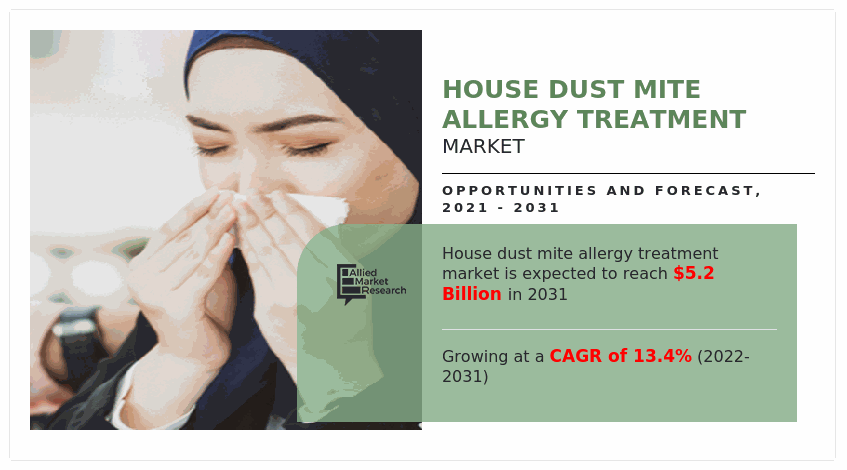
Furthermore, increase in prevalence of asthma, house dust allergy and allergic rhinitis drives house dust mite allergy treatment market share. The population diagnosed asthma and allergic rhinitis is highly vulnerable to house dust mite allergy, thus driving the house dust mite allergy treatment market growth. In addition, increase in prevalence of indoor air pollutant such as house dust mites, pet dust, and pollens is anticipated to contribute toward the growth of the market. A person’s immune system reacts to allergens present in indoor such as dust mite, and develops allergic rhinitis. Moreover, increase in initiatives to spreading knowledge regarding different types of allergies propels the growth of the market
Furthermore, technological developments in the pharmaceutical industry to manufacture advanced anti-allergy products are expected to provide remunerative opportunities for expansion of the global house dust mite allergy treatment market during the house dust mite allergy treatment market forecast period. Moreover, strong presence of key manufacturing companies to manufacture and distribute house dust mite allergy treatment products and rise in expenditure on healthcare products propel the growth of the market. Initiatives taken by government and private organizations to develop pharmaceutical industry propel the growth of the market. However, rise in hygiene practices reduces the occurrence of house dust mite allergy, which, in turn, is expected to restrict the market growth.
Global House Dust Mite Allergy Treatment Market Segmentation
The house dust mite allergy treatment market is segmented into treatment, type, route of administration, distribution channel, and region. By treatment, the market is categorized into antihistamine, immunotherapy, and others. On the basis of type, it is divided into prescription-based drugs and over-the-counter drugs. Depending on route of administration, it is categorized into oral medication and nasal administration. By distribution channel, it is segregated into hospital pharmacy, online pharmacy, and retail pharmacy.
Region wise, the market is analyzed across North America (the U.S., Canada, and Mexico), Europe (Germany, France, the UK, and rest of Europe), Asia-Pacific (Japan, China, India, Australia, South Korea, and rest of Asia-Pacific), and LAMEA (Brazil, Saudi Arabia, South Africa, and rest of LAMEA).
Segment Review
Depending on treatment, the others segment dominated the market in 2021, and this trend is expected to continue during the forecast period, owing to advancements in R&D activities in the pharmaceutical sector and increase in number of key manufacturers. However, the antihistamine segment is expected to witness considerable growth during the forecast period, owing to increase in demand for antihistamine
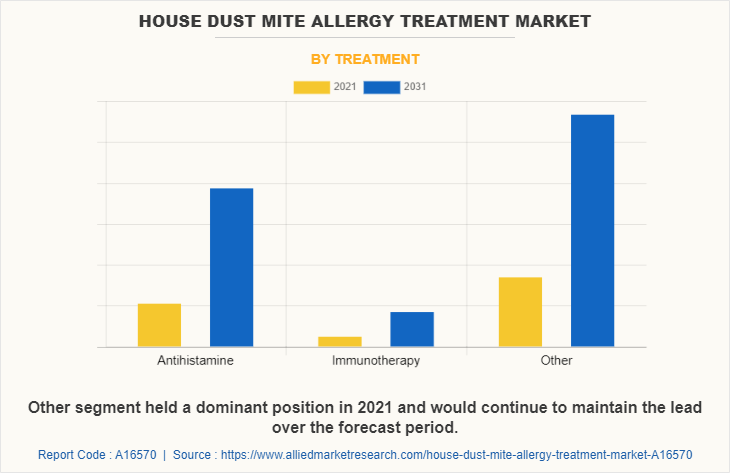
By type, the prescription-based drugs segment was the major contributor in 2021, and is expected to maintain its lead during the forecast period, owing to increase in prevalence of house dust mite allergy diseases and initiatives taken by government & private organization to spread awareness about allergic disease.
However, the over-the-counter drugs segment is expected to witness considerable growth during the forecast period, owing to increase in demand for over-the-counter drugs and increase in number of approval for over-the-counter anti-allergic drugs.
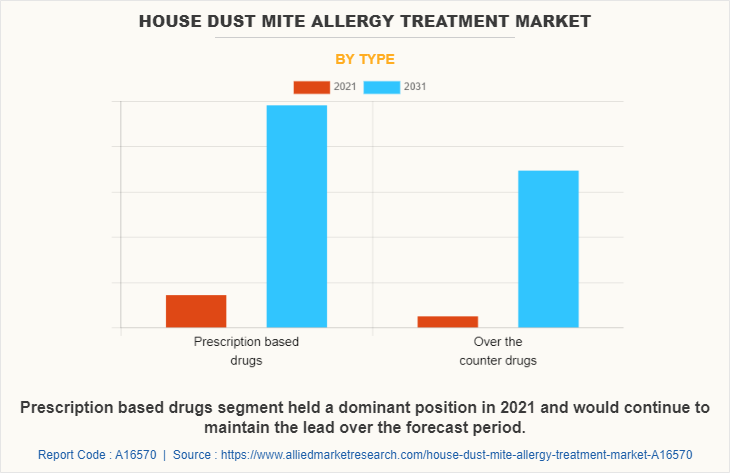
On the basis of route of administration, the oral medication segment dominated the market in 2021, and this trend is expected to continue during the forecast period, owing to increase in preference for oral route of administration, rise in number of U.S. FDA approvals for drugs, and advancements in R&D activities in the pharmaceutical sector.
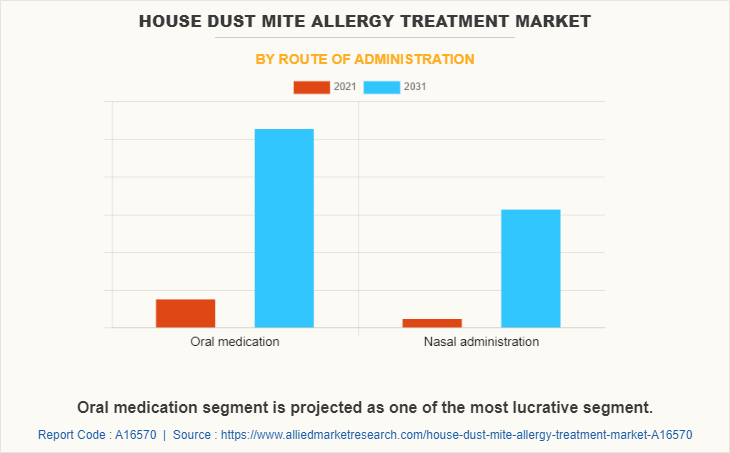
By distribution channel, the hospital pharmacy segment was the major contributor in 2021, and is expected to maintain its lead during the forecast period, owing to rise in prevalence of allergic diseases, surge in demand for monoclonal antibodies, and initiatives taken by government for advancement of hospital pharmacies.
However, the online pharmacy segment is expected to witness considerable growth during the forecast period, due to advancements in technology in the healthcare sector and rise in demand for remote services.
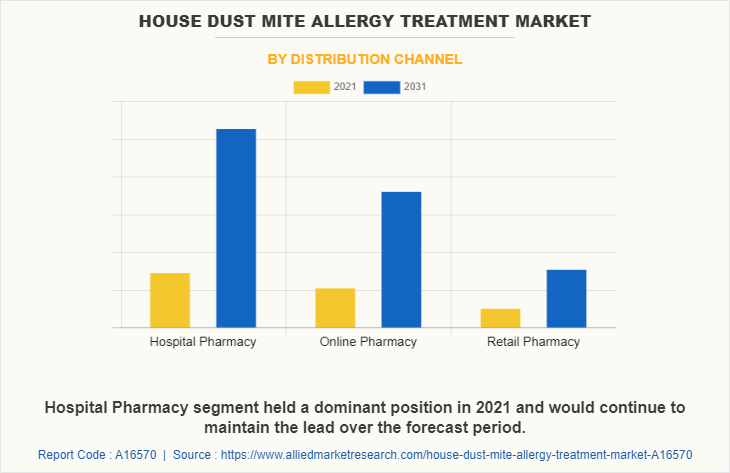
Europe garnered a major share in the house dust mite allergy treatment market in 2021, and is expected to continue to dominate during the forecast period, owing to rise in prevalence of asthma & allergic rhinitis, increase in number of in-house dust pollution, presence of key players, and development in increase in R&D activities in the pharmaceutical sector in the region.
However, Asia-Pacific is expected to register highest CAGR of 14.4% from 2022 to 2031, owing to increase in prevalence of house dust mite allergy diseases, rise in awareness about spreading knowledge regarding allergens, surge in healthcare expenditure, and rise in adoption of immunotherapy drugs for the treatment of house dust mite allergies.
The key players operating in the global house dust mite allergy treatment market include ALK-Abello A/S, Allergy Therapeutics PLC, Bayer AG, Catalent Pharma Solutions Limited, GlaxoSmithKline Plc., Johnson and Johnson, Merz Pharma GmbH an Co. KGaA, Sanofi, Seqirus UK Limited, and Shionogi & Co. Ltd.
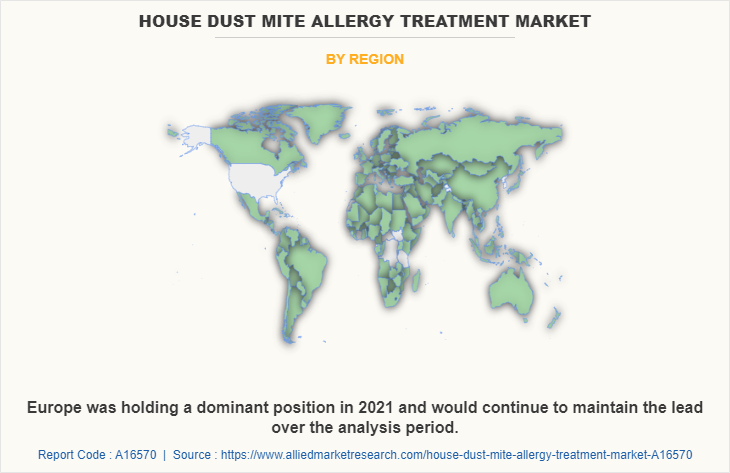
Key Benefits For Stakeholders
- This report provides a quantitative analysis of the market segments, current trends, estimations, and dynamics of the house dust mite allergy treatment market analysis from 2021 to 2031 to identify the prevailing house dust mite allergy treatment market opportunity.
- The market research is offered along with information related to key drivers, restraints, and opportunities.
- Porter's five forces analysis highlights the potency of buyers and suppliers to enable stakeholders make profit-oriented business decisions and strengthen their supplier-buyer network.
- In-depth analysis of the house dust mite allergy treatment market segmentation assists to determine the prevailing market opportunities.
- Major countries in each region are mapped according to their revenue contribution to the global market.
- Market player positioning facilitates benchmarking and provides a clear understanding of the present position of the market players.
- The report includes the analysis of the regional as well as global house dust mite allergy treatment market trends, key players, market segments, application areas, and market growth strategies.
House Dust Mite Allergy Treatment Market Report Highlights
| Aspects | Details |
| By Treatment |
|
| By Type |
|
| By Route of administration |
|
| By Distribution channel |
|
| By Region |
|
| Key Market Players | ALK Abello A S, Bayer AG, Allergy Therapeutics PLC, Sanofi, johnson and johnson md&d, Merz Pharma GmbH an Co. KGaA, Seqirus UK Limited, Catalent Pharma Solutions Limited, GlaxoSmithKline plc., Shionogi and Co. Ltd. |
Analyst Review
According to the insights of the CXOs of top-level companies, antihistamines, immunotherapies, corticosteroids, and nasal irrigations are the common treatment approaches for house dust mite allergy. For instance, in May 2021, the Glenmark Pharmaceutical Ltd., a global pharmaceutical companies, announced the launch of Ryaltris AZ nasal spray, which is used for the treatment of allergic rhinitis. Allergic rhinitis is one of the most common symptoms associated with house dust mite allergy reaction allergy. Moreover, in September 2020, the U.S Food and Drug Administration (FDA) announced the approval to supplement the Biologics License Application (BLA) under section 351(a) of the Public Health Service Act for house dust mite allergen extract
The total market value of house dust mite allergy treatment market is $1,481.2 million in 2021.
The forecast period in the report is from 2022 to 2031
The market value of house dust mite allergy treatment market in 2022 was $1,676.7 million
The base year for the report is 2021.
Yes, house dust mite allergy treatment companies are profiled in the report
The top companies that hold the market share in house dust mite allergy treatment market are ALK-Abello A/S, Allergy Therapeutics PLC, Bayer AG, Catalent Pharma Solutions Limited, GlaxoSmithKline Plc., Johnson and Johnson, Merz Pharma GmbH an Co. KGaA, Sanofi, Seqirus UK Limited, and Shionogi & Co. Ltd
Asia-Pacific is expected to register highest CAGR of 14.4% from 2022 to 2031, owing to increase in prevalence of house dust mite allergy diseases, rise in awareness about spreading knowledge regarding allergens, surge in healthcare expenditure, and rise in adoption of immunotherapy drugs for the treatment of house dust mite allergies
The key trends in the house dust mite allergy treatment market are increase in prevalence of allergic diseases associated with house dust mites, rise in demand for immunological products, increase in funding from private & government organizations for development of pharmaceutical manufacturing segments, and rise in R&D activities for manufacturing of anti-allergy drugs
Loading Table Of Content...



